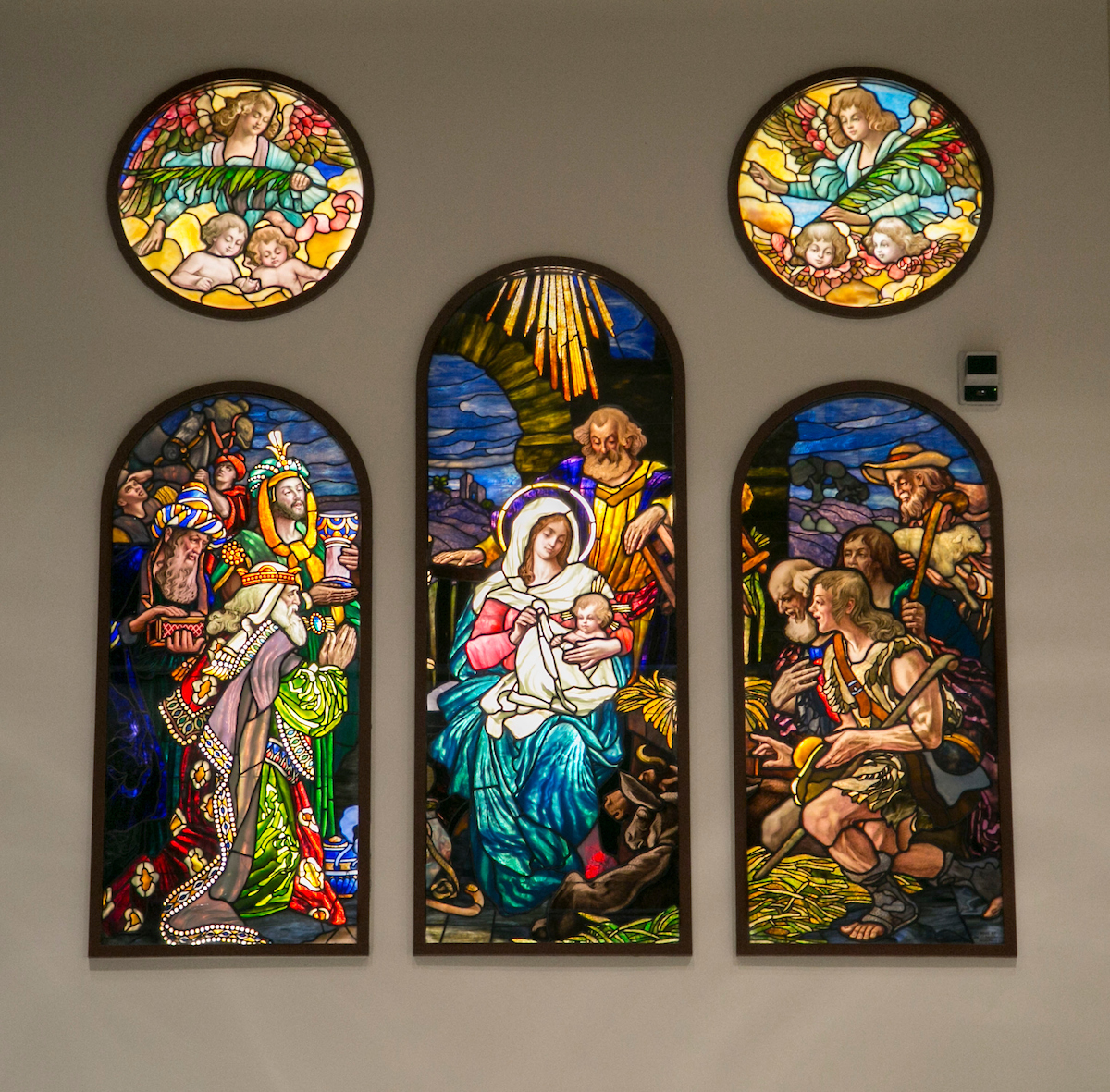 Artists Joseph Flanagan and William Biedenweg's stained glass panels, "Adoration of the Magi," located in DePaul's John T. Richardson Library. (DePaul University/Jamie Moncrief)
Artists Joseph Flanagan and William Biedenweg's stained glass panels, "Adoration of the Magi," located in DePaul's John T. Richardson Library. (DePaul University/Jamie Moncrief)
Upon entering DePaul’s John. T. Richardson Library from the Quad, visitors are greeted with stained glass windows depicting a scene familiar to many, especially at this time of year—the nativity. The five glass panels that decorate the east end of Kelly Hall are backlit, illuminating a colorful triptych image of the infant Jesus resting with Mary and Joseph, the three Magi kneeling on the left, shepherds and their sheep on the right, and angels hovering above.
One element of the familiar scene is absent, however: the bright star that led the Magi to visit Jesus in the manger. This missing Star of Bethlehem hints at a deeper story behind the windows. A little historical investigating helps reveal some of that story, which takes the art glass panels to various locations over the span of a century.
The “Adoration of the Magi” windows originated in Chicago in the glass manufacturing studio of Flanagan & Biedenweg Co. Artists Joseph E. Flanagan and William E. Biedenweg founded the firm in 1878, and by 1900 they had become the largest stained glass supplier in the city. It was around that time the company created DePaul’s nativity windows, because they made their way to the 1904 World’s Fair in St. Louis. Flanagan & Biedenweg Co. earned the fair’s Grand Prize for American Glass for the Magi panel.
Shortly after returning to Chicago from St. Louis, the windows found a home at DePaul Academy, where several of Flanagan’s children attended school. Architectural plans for a new building to house DePaul Academy in 1906 included provisions for “the Nativity in art glass” on the “middle windows on the second floor front.” Installed when the building was completed the following year, exterior images of the building provide evidence of a sixth panel located at the top and center of the triptych.
The windows adorned an interior space that housed both the school’s library and the “Uptown Campus” library in those early years. Yearbooks mention the library’s pride in their stained glass and students’ tendency to visit the location to escape the daily grind. In a 1930 spread in “The DePaulia,” an interior shot of the library provides a closer look at the imagery depicted in the sixth panel, which includes the element missing from the nativity windows today—the Star of Bethlehem. Sometime after the campus library moved out of the building in 1930, the space was converted into a school chapel, which offered a new, more ecclesiastical setting for the stained glass.
In 1968, financial burdens caused DePaul Academy to close and its building was turned over to DePaul University. The university removed the windows during remodeling in 1976, but stored them for safekeeping. A few years later, a curator from the Chicago Historical Society requested to borrow the award-winning Magi window for an upcoming exhibit featuring stained glass made in Chicago. Arrangements were made, and that window was transported to North Clark St., where it was on display in the exhibition from November 1979 to July 1980.
Once returned to the university, the windows moved to the basement of St. Vincent’s Church, where they laid unseen for almost a decade. Unearthed in 1989, the windows made their way across campus to the Special Collections department, located at the time in Schmitt Academic Center. As plans for the new John T. Richardson Library were coming together, discussions about displaying the stained glass in the new building came up.
The windows were in dire need of restoration, but no one was certain who would pay for that work and the architects had some reservations. Despite those concerns, everything came together. The windows were cleaned and installed in the new library in 1992. They remain there today, serving as stunning examples of stained glass art connecting us to stories of DePaul’s past.
However, the mystery of the missing Star of Bethlehem panel remains unsolved.